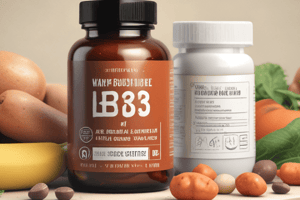Podcast
Questions and Answers
What is the primary purpose of vitamin-mineral supplements?
What is the primary purpose of vitamin-mineral supplements?
- To enhance physical performance in athletes
- To provide all necessary nutrients for a balanced diet
- To bridge occasional nutrient gaps for those with healthy diets (correct)
- To replace proper meals during dietary restrictions
Which group of individuals is most likely to require vitamin-mineral supplements?
Which group of individuals is most likely to require vitamin-mineral supplements?
- Individuals with no dietary restrictions
- Those who are pregnant and have increased nutrient needs (correct)
- Individuals following a high-calorie diet
- Individuals consuming a variety of processed foods
What are the three main groups of vitamin-mineral supplements?
What are the three main groups of vitamin-mineral supplements?
- Essential, additional, and excessive
- Basic, high-potency, and specialized (correct)
- Standard, enhanced, and comprehensive
- Basic, organic, and synthetic
What is a key consideration when choosing a vitamin-mineral supplement?
What is a key consideration when choosing a vitamin-mineral supplement?
Which of the following populations is NOT typically considered vulnerable in the context of nutritional needs?
Which of the following populations is NOT typically considered vulnerable in the context of nutritional needs?
Which characteristic may indicate a need for vitamin-mineral supplements?
Which characteristic may indicate a need for vitamin-mineral supplements?
What is the purpose of the Dietary Guidelines?
What is the purpose of the Dietary Guidelines?
How many pages did the 2020 Dietary Guidelines report contain?
How many pages did the 2020 Dietary Guidelines report contain?
What role do vitamin-mineral supplements play in healing?
What role do vitamin-mineral supplements play in healing?
What is one of the key themes of the 2020–2025 Dietary Guidelines?
What is one of the key themes of the 2020–2025 Dietary Guidelines?
Why is guidance important when choosing vitamin-mineral supplements?
Why is guidance important when choosing vitamin-mineral supplements?
What does the Dietary Guidelines encourage people to limit in their diets?
What does the Dietary Guidelines encourage people to limit in their diets?
Which of the following best describes the emphasis of the Dietary Guidelines?
Which of the following best describes the emphasis of the Dietary Guidelines?
Which value is NOT one of the overarching principles of the 2020–2025 Dietary Guidelines?
Which value is NOT one of the overarching principles of the 2020–2025 Dietary Guidelines?
Which meal contains a significant source of Vitamin A?
Which meal contains a significant source of Vitamin A?
What is the primary reason for the variation in recommended dosage for vitamins and minerals?
What is the primary reason for the variation in recommended dosage for vitamins and minerals?
Which vitamin is provided at a higher percentage of the Daily Value in a medium-sized orange?
Which vitamin is provided at a higher percentage of the Daily Value in a medium-sized orange?
What type of health claim describes the relationship between a food and reducing the risk of a specific disease?
What type of health claim describes the relationship between a food and reducing the risk of a specific disease?
Which food is a source of both Vitamin E and healthy fats?
Which food is a source of both Vitamin E and healthy fats?
Which group has the highest recommended daily iron intake?
Which group has the highest recommended daily iron intake?
In regards to nutrient bioavailability, which is considered more effective?
In regards to nutrient bioavailability, which is considered more effective?
What element of dietary supplements cannot mention any specific disease?
What element of dietary supplements cannot mention any specific disease?
Which vitamin and mineral combination is specifically effective in slowing age-related macular degeneration (AMD)?
Which vitamin and mineral combination is specifically effective in slowing age-related macular degeneration (AMD)?
Which of these is NOT mentioned as a form in which vitamin-mineral supplements can be found?
Which of these is NOT mentioned as a form in which vitamin-mineral supplements can be found?
Which food provides a source of calcium at a significant percentage of the Daily Value?
Which food provides a source of calcium at a significant percentage of the Daily Value?
What characterizes high-potency vitamin and mineral supplements?
What characterizes high-potency vitamin and mineral supplements?
How has the Dietary Supplement Health and Education Act (DSHEA) of 1994 impacted the regulation of dietary supplements?
How has the Dietary Supplement Health and Education Act (DSHEA) of 1994 impacted the regulation of dietary supplements?
Which category of vitamin and mineral supplements is designed for specific needs like immune function or eye health?
Which category of vitamin and mineral supplements is designed for specific needs like immune function or eye health?
What is the recommended approach for nurses when advising clients about vitamins and minerals?
What is the recommended approach for nurses when advising clients about vitamins and minerals?
What is a disadvantage of relying on dietary supplements instead of whole foods?
What is a disadvantage of relying on dietary supplements instead of whole foods?
Which of the following statements about the dietary supplement market is accurate?
Which of the following statements about the dietary supplement market is accurate?
What is typically included in a basic vitamin and mineral supplement?
What is typically included in a basic vitamin and mineral supplement?
Study Notes
Supplements Overview
- Fresh and minimally processed foods are the best sources of vitamins and minerals.
- Nearly 60% of the population uses multiple vitamin and mineral supplements.
Characteristics of Supplement Users
- Individuals likely to need supplements include:
- Those on restricted diets
- Pregnant women
- Individuals experiencing appetite loss due to illness or surgery
- People with severe food allergies
- Those with depleted immune systems
Categories of Vitamin and Mineral Supplements
- Basic:
- Contains daily dosages that do not exceed daily values (DVs).
- Tailored for specific demographics such as age and sex.
- High-Potency:
- Contains nutrients exceeding 100% of DVs.
- Often formulated for specific needs such as prenatal care.
- Specialized:
- Targeted for specific health needs (e.g., immune support, eye health).
- Can contain higher concentrations of certain nutrients.
Regulations and Market Dynamics
- The FDA regulates vitamin-mineral supplements but has limited authority.
- The Dietary Supplement Health and Education Act (DSHEA) of 1994 allows manufacturers to introduce supplements without pre-market approval.
- Since DSHEA, dietary supplements have surged in number—growing nearly 20 times since 1994.
Food-First Approach
- A food-first strategy is recommended for obtaining vitamins and minerals.
- Foods provide complex carbohydrates, fiber, protein, unsaturated fats, and antioxidants.
- Example daily menu includes nutritious meals like cereal with low-fat milk, tuna sandwiches, and roasted almonds.
Nutritional Content of Common Foods
- A small carrot provides 6000 IU of Vitamin A (100% DV).
- An ounce of almonds contains over 7 mg of Vitamin E (50% DV).
- A medium orange has 70 mg of Vitamin C (78% DV).
Health Claims on Supplement Labels
- Manufacturers may claim:
- Health: Links between ingredients and reduced disease risk.
- Nutrient: Information on relative nutrient amounts.
- Structure/Function: Effects on body systems without mentioning diseases.
Recommended Dietary Allowances (RDAs)
- RDAs are updated every 5–10 years and serve as goals for healthy individuals.
- Specific RDA examples for iron intake:
- Adolescent females: 15 mg
- Adult females: 18 mg
- Adolescent males: 11 mg
- Adult males: 8 mg
Market Segmentation of Supplements
- Supplements tailored to different demographics:
- Children's vitamins feature catchy packaging and flavors.
- Prenatal vitamins use pastel coloring, while seniors’ vitamins come in silver packaging.
Scientific Perspective on Supplements
- Little scientific backing supports the need for vitamin-mineral supplements in the absence of deficiency.
- Foods are typically more bioavailable than supplements.
- Supplements may be essential in certain circumstances, but a food-first approach is emphasized.
Dietary Guidelines and Nutritional Insights
- RDAs were initially developed during World War II for nutritional guidance.
- The Dietary Guidelines, updated every five years, emphasize the importance of nutrient-dense food choices.
- The 2020–2025 Dietary Guidelines promote the concept of “Make Every Bite Count,” encouraging healthy dietary patterns throughout all life stages.
Studying That Suits You
Use AI to generate personalized quizzes and flashcards to suit your learning preferences.
Description
This quiz focuses on the role of vitamin and mineral supplements in nutrition, wellness, and their evaluation as part of a nutritional plan. It also explores the special considerations for vulnerable populations and how supplements can impact overall health across the lifespan.




